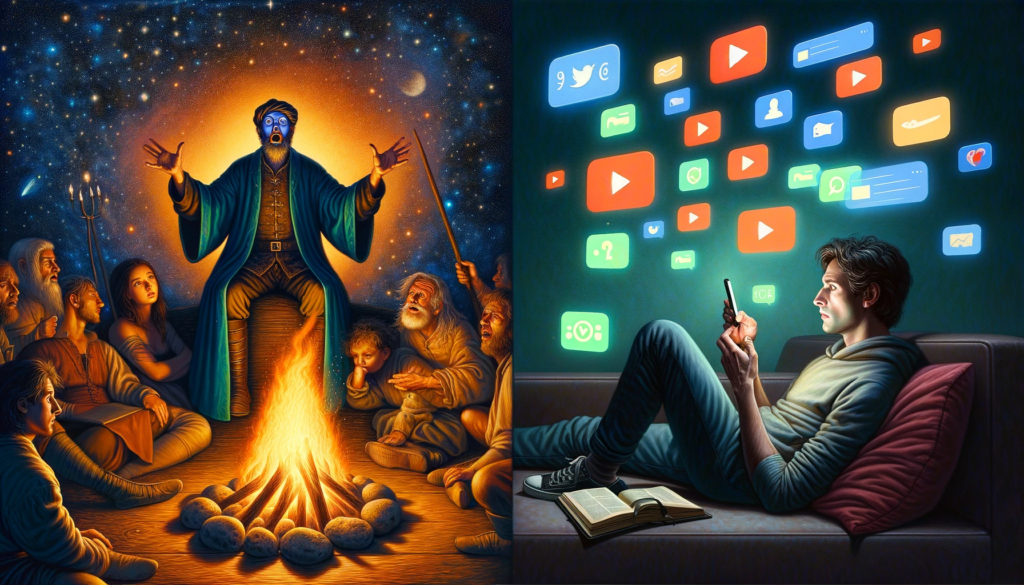In a 10 second world, how do you create engaging videos that are watched for 10+ minutes?
The Narrative Arc was the fundamental engagement tool of storytellers for Millenia, but using it will lead to utter failure on YouTube.
I’m going to show you a better approach I call the YouTube Wave and help you apply these principles to create videos that perform in the top 1%.

The narrative arc, or storytelling arc, was first described by Aristotle’s “Poetics” in 335 BCE.
Aristotle believed that every story should have a clear beginning, middle, and end. In the 19th century, this idea was expanded to include detailed parts like the climax — the most thrilling point of the story.

The arc is a guide for creating engaging stories. It’s effective because it mirrors the ups and downs we experience in real life, making it relatable and interesting for people to follow.
It’s had a profound impact on humanity—shaping the way we are entertained or informed through ancient mythology, the Bible and Quran, Shakespearean plays, novels, movies, and even video games.
So why does it FAIL on YouTube?

Imagine you’re sitting by a fire long ago, under a sky full of stars. A bard is sharing an exciting tale. The fire’s warm light dances on your face as you listen, completely caught up in the story. Your attention is on the bard and the adventure unfolding with each word.
Now, picture yourself today. You’re on your couch scrolling through YouTube on your phone, but it’s hard to focus. Every few seconds, a beep or buzz from a text or app pulls you away. Unlike the firelit night with the bard—where every word pulled you deeper into the story—here, with so many distractions, it’s tough to dive into any story at all.
Storytelling used to be a time to get lost in the moment. Now, it’s easy to get distracted and miss out on the magic.
Creators on platforms like X and TikTok adapted to this new distraction-heavy environment by reducing stories to ideas that can be consumed in seconds.
But YouTubers with a focus on long form videos don’t have the same luxury. There had to be a solution. Thus, the YouTube Wave was born.

The most successful YouTube creators have figured out that Curiosity is what breeds Engagement.
The first 30 seconds of a YT video are the most important. This is your best chance to hook the viewer and convince them that what you have to offer is worth their attention.
But unlike the traditional narrative arc with a single buildup and climax, you won’t keep viewers’ attention on YT without continually re-engaging curiosity.
You can do this with a series of curiosity gaps and payoffs. Some refer to these series as “opening loops” with the idea that the curiosity gap opens a loop and the payoff closes it. I prefer to think of them as Waves as depicted in the YouTube Wave illustration above.
Curiosity gaps are moments where you hint at what’s coming up without revealing everything. This strategy keeps viewers curious and engaged, encouraging them to watch until the end to get all the details.
Then come payoffs, which might be surprising reveals, funny moments, or key pieces of information. This structure helps maintain a high level of engagement by delivering satisfying moments throughout the video.
YT videos typically conclude with a call to action such as asking viewers to like, subscribe, or check out another video.
An even more effective tactic was described recently by @GeorgeBlackman_, who suggests referring back to a subject previously covered in the video, linking that subject to another video on your channel, and explaining that they only way to understand the full story is to watch that next video. In effect, this creates a never-ending wave of curiosity gaps.
The YouTube Wave is about creating a dynamic and engaging experience that keeps viewers clicking, watching, and interacting.
With attention spans shorter than ever, this structure is the only way to succeed on a platform where hundreds of hours of content are uploaded every minute.
Looking for help applying these principles to create more engaging YouTube videos? Check out Subscribr, my new YouTube scriptwriting platform. Subscribr will give you instant feedback to improve the YouTube Wave in your scripts.
Join the waistlist at https://subscribr.ai.
